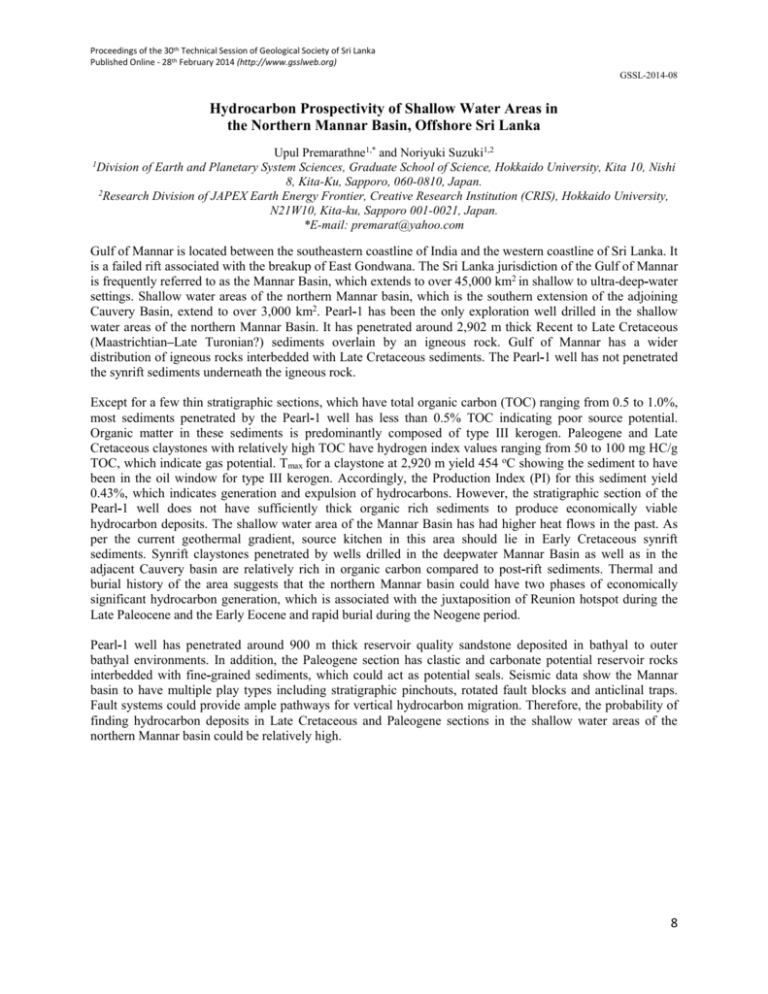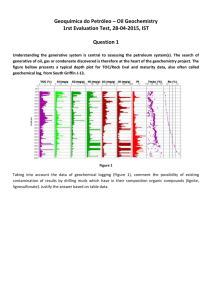GSSL-2014
advertisement

Proceedings of the 30th Technical Session of Geological Society of Sri Lanka Published Online - 28th February 2014 (http://www.gsslweb.org) GSSL-2014-08 Hydrocarbon Prospectivity of Shallow Water Areas in the Northern Mannar Basin, Offshore Sri Lanka 1 Upul Premarathne1,* and Noriyuki Suzuki1,2 Division of Earth and Planetary System Sciences, Graduate School of Science, Hokkaido University, Kita 10, Nishi 8, Kita-Ku, Sapporo, 060-0810, Japan. 2 Research Division of JAPEX Earth Energy Frontier, Creative Research Institution (CRIS), Hokkaido University, N21W10, Kita-ku, Sapporo 001-0021, Japan. *E-mail: premarat@yahoo.com Gulf of Mannar is located between the southeastern coastline of India and the western coastline of Sri Lanka. It is a failed rift associated with the breakup of East Gondwana. The Sri Lanka jurisdiction of the Gulf of Mannar is frequently referred to as the Mannar Basin, which extends to over 45,000 km2 in shallow to ultra-deep-water settings. Shallow water areas of the northern Mannar basin, which is the southern extension of the adjoining Cauvery Basin, extend to over 3,000 km2. Pearl-1 has been the only exploration well drilled in the shallow water areas of the northern Mannar Basin. It has penetrated around 2,902 m thick Recent to Late Cretaceous (Maastrichtian–Late Turonian?) sediments overlain by an igneous rock. Gulf of Mannar has a wider distribution of igneous rocks interbedded with Late Cretaceous sediments. The Pearl-1 well has not penetrated the synrift sediments underneath the igneous rock. Except for a few thin stratigraphic sections, which have total organic carbon (TOC) ranging from 0.5 to 1.0%, most sediments penetrated by the Pearl-1 well has less than 0.5% TOC indicating poor source potential. Organic matter in these sediments is predominantly composed of type III kerogen. Paleogene and Late Cretaceous claystones with relatively high TOC have hydrogen index values ranging from 50 to 100 mg HC/g TOC, which indicate gas potential. Tmax for a claystone at 2,920 m yield 454 oC showing the sediment to have been in the oil window for type III kerogen. Accordingly, the Production Index (PI) for this sediment yield 0.43%, which indicates generation and expulsion of hydrocarbons. However, the stratigraphic section of the Pearl-1 well does not have sufficiently thick organic rich sediments to produce economically viable hydrocarbon deposits. The shallow water area of the Mannar Basin has had higher heat flows in the past. As per the current geothermal gradient, source kitchen in this area should lie in Early Cretaceous synrift sediments. Synrift claystones penetrated by wells drilled in the deepwater Mannar Basin as well as in the adjacent Cauvery basin are relatively rich in organic carbon compared to post-rift sediments. Thermal and burial history of the area suggests that the northern Mannar basin could have two phases of economically significant hydrocarbon generation, which is associated with the juxtaposition of Reunion hotspot during the Late Paleocene and the Early Eocene and rapid burial during the Neogene period. Pearl-1 well has penetrated around 900 m thick reservoir quality sandstone deposited in bathyal to outer bathyal environments. In addition, the Paleogene section has clastic and carbonate potential reservoir rocks interbedded with fine-grained sediments, which could act as potential seals. Seismic data show the Mannar basin to have multiple play types including stratigraphic pinchouts, rotated fault blocks and anticlinal traps. Fault systems could provide ample pathways for vertical hydrocarbon migration. Therefore, the probability of finding hydrocarbon deposits in Late Cretaceous and Paleogene sections in the shallow water areas of the northern Mannar basin could be relatively high. 8



![Georgina Basin Factsheet [DOCX 1.4mb]](http://s3.studylib.net/store/data/006607361_1-8840af865700fceb4b28253415797ba7-300x300.png)



